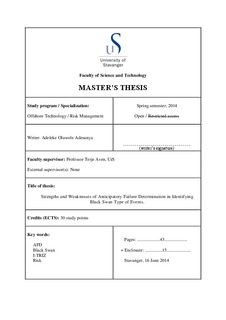| dc.contributor.author | Adesanya, Adeleke | |
| dc.date.accessioned | 2014-10-13T12:29:58Z | |
| dc.date.available | 2014-10-13T12:29:58Z | |
| dc.date.issued | 2014-06-16 | |
| dc.identifier.uri | http://hdl.handle.net/11250/223615 | |
| dc.description | Master's thesis in Offshore technology / risk management | nb_NO |
| dc.description.abstract | Some of the systemic/operational failures that happen in industries like oil and gas, production industry, financial institution are associated with unanticipated/surprise events. These events are known as Black Swan Events; the way in which they occur is so surprising that no one would have predicted the occurrence. When these events happen, the likelihood for extreme consequences cannot be ruled out.
“Taleb described a Black Swan as a highly improbable event with three principle characteristics: its unpredictable; its massive; and, after it has happened, our desire to make it appear less random and more predictable than it was. The astonishing success of Google was a Black Swan; so was 9/11”
- Prof Nassim Nicolas Taleb
The consequences of this black swan type of events remain a challenge for many industries because of the failure of traditional risk assessment methods in providing solution to meeting these types of event. Therefore, it has become necessary to improve our hazard/threat identification methods due to the fear of the unforeseen events that could threaten the safety and security of our system or operation.
A new tool for failure and risk analysis called Anticipatory Failure Determination (AFD) has been introduced. It is based on the theory of inventive problem solving and it has two broad applications namely Anticipatory Failure Analysis (AFD-1) and Anticipatory Failure Prediction (AFD-2). The main objective of AFD-1 is to find the causes of a failure that has already occurred while in AFD-2, the goal is to identify all possible failures that have not yet occurred.
This paper will present a new tool for failure and risk analysis called Anticipatory Failure Determination. It will focus on identifying the strengths and weaknesses of this new tool in identifying black swan type of event. General overview and discussion of this tool will be done as well as demonstrating its applicability using a practical example. | nb_NO |
| dc.language.iso | eng | nb_NO |
| dc.publisher | University of Stavanger, Norway | nb_NO |
| dc.relation.ispartofseries | Masteroppgave/UIS-TN-IKM/2014; | |
| dc.subject | sorte svaner | nb_NO |
| dc.subject | risikostyring | nb_NO |
| dc.subject | offshore teknologi | nb_NO |
| dc.subject | black swans | nb_NO |
| dc.title | Strengths and weaknesses of anticipatory failure determination in identifying black swan type of events | nb_NO |
| dc.type | Master thesis | nb_NO |
| dc.subject.nsi | VDP::Technology: 500::Marine technology: 580::Offshore technology: 581 | nb_NO |
